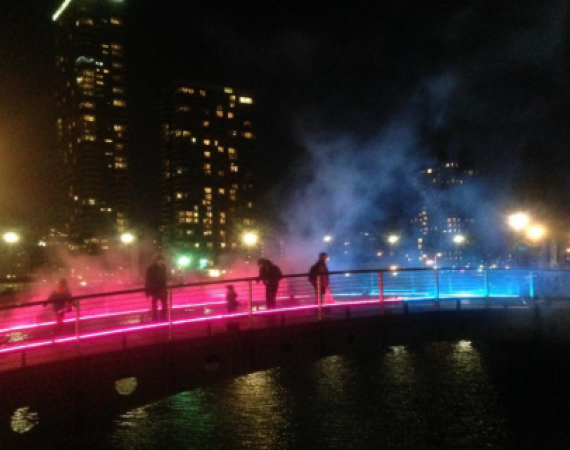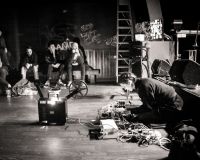Studio blog
Posted on Tue 20 Jan 2015
The Research for the Holy (app)Trail
We are on the cusp of a lot of exciting new research this month, as academics prepare to investigate locative media and site-specific history, the neuroscience of taste and the process and benefits of co-developing projects with children. Victoria Forrest has also launched her brilliant Apps for the…

Tine Bech's On the Bridge - @t_bech
Posted by

Jasmine Butt
Jasmine is a musician, synth builder and AV artist who is currently exploring modular synthesis.We are on the cusp of a lot of exciting new research this month, as academics prepare to investigate locative media and site-specific history, the neuroscience of taste and the process and benefits of co-developing projects with children. Victoria Forrest has also launched her brilliant Apps for the Arts development platform.
Applications are currently open for a REACT PhD Studentship, which has emerged out of a collaboration between University of Exeter’s College of Humanities and residents and geo-location technology experts, Calvium. The Studentship will be an opportunity to explore how digital approaches and locative media have unlocked the potential for re-inscribing past meanings and narratives to place through overlaying site-specific information. Calvium are renowned for their App Trails, which use GPS to allow you to navigate site-specific content while walking around a city. A brilliant example of this is their app, Hidden Florence, where they took Bonsignori’s 1584 city map and precisely pegged it to a modern street map of Florence. The result is a Google-like period map, where GPS tracks your progress through the streets and triggers stories. The site-specific audio lets you explore the city through the eyes of a 1490s wool worker called Giovanni. The affordances of emerging locative technology is a hugely relevant, and boundless topic. We can’t wait to see what comes of the research.
Our resident food expert, James Wheale has just been awarded EU funding to work alongside Bioscience research centre, Catim and UWE’s neuroscience department. He will be using EEG brain scanners to research how our experience of flavours can be affected by storytelling. As soon as the scanners arrive and work gets underway, we will be sure to have lots to write about!
REACT held a Play Sandbox workshop in the Studio on Wednesday. The project teams took part in workshops around how to tell stories and pitch projects that are still in development. REACT Producer Jo Lansdowne has recently posted a brilliant update on where the projects are, and the kinds of questions around play that the teams are currently pondering. Residents Helen Manchester and Alison Oldfield have just begun their Play Sandbox research. They are investigating what happens when children are involved in the process of collaborative R&D. Play Sandbox have recruited a group of 8 – 12 year olds to help advise on the projects. The researchers are finding out what these ‘Young Coaches’ bring to the development of individual products through collaborations over the 4 months of the projects’ incubation. The research will have a strong focus on the experiences of those working within the Sandbox, including project teams, Young Coaches, parents and the REACT team.
Victoria Forrest has been working on a development platform called Apps for the Arts, which will help arts organisations to share the cost of developing and launching their festival apps. The resulting apps will include features such as diaries and planners for people to organise what to see and when, along with GPS mapping for navigating between the venues. The app also provides organisers with anonymous visitor date, to monitor footfall etc and help them plan future events. The Palestinian film festival were the first to use the platform, which is currently in beta stage testing. If you are interested in using the app, and would like more information, contact tor@designbyvictoria.com
Studio residents Tine Bech and Tarim installed interactive Light artwork, On the Bridge on the Cubitt steps at the bridge in Canary Wharf, as part of the Winter Light Festival’s illuminations. On The Bridge invites audiences to interact with each other and the bridge itself, which illuminates as people walk across it. Visitors activate explosions of pink light, created by a combination of sensors, lighting and smoke machines as they pass different spots on the bridge. If they run or work together the whole bridge turns pink at the same time.